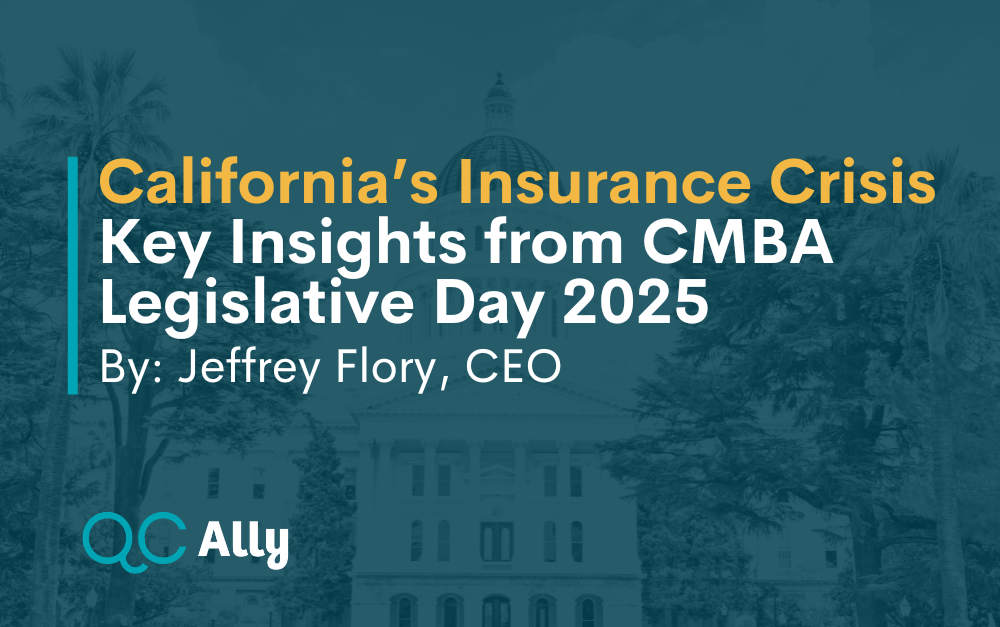California’s Insurance Crisis: Key Insights from California MBA Legislative Day 2025
By: Jeffrey Flory, CEO of QC Ally
On March 4th, more than 300 professionals representing five housing and insurance-related organizations gathered in Sacramento for the California MBA’s Annual Coalition Legislative Day. Unlike past events that covered a variety of mortgage banking topics, Legislative Day 2025 was solely focused on the California insurance crisis. Representatives from the California MBA, California Building Industry Association, California Bankers Association, American Property Casualty Insurance Association, and Personal Insurance Federation of California engaged in productive discussions and advocacy efforts to address this pressing issue.
About California’s Insurance Crisis
California’s current insurance crisis is, in part, a self-inflicted challenge. Voters went to the polls in 1998 and voted in favor of Proposition 103, which was designed to protect consumers from unfair insurance rates and practices, encourage a competitive marketplace, and ensure that insurance is fair, accessible, and affordable for all Californians. Key provisions of the proposition included:
- Requiring insurers to get prior approval from the California Department of Insurance for rate changes.
- Mandating data-driven justifications for rate hikes.
- Allowing consumers to file rate objections through public intervenors at rate hearings.
Over time, insurance companies have been unable to adjust rates in line with rising risks. As a result, seven of the top twelve insurers in California have either stopped writing policies or severely limited the geography where policies are written. One insurance agent at the event shared that their company has lost over $1 Billion (with a B) in California over the past five years as they have been unable to price appropriately for the risk assumed with their policies. He noted breaking even in California would be considered a success.
The Growing Reliance on the FAIR Plan
With fewer private insurers offering policies, many property owners have turned to the California FAIR Plan, which is a fire insurance program created by the State in the late 1960s to provide coverage to those unable to secure private insurance. The FAIR plan was meant as an insurance provider of last resort, but it has quickly become the third-largest issuer of policies in the last year.
Couple that with the fact that six of the ten deadliest wildfires in California occurred in the last 25 years, and we have reached a crisis point in insurance availability.
A Path Forward: The Sustainable Insurance Strategy
Ricardo Lara, California’s Insurance Commissioner, has introduced the Sustainable Insurance Strategy (SIS). In short, it aims to make insurance accessible again for all Californians, create a resilient insurance market, and protect communities from the impacts of fire hazards. The SIS will:
- Require insurance companies to write no less than 85% of their statewide market share in distressed areas.
- Transition FAIR Plan policyholders back to the private market.
- Incorporate catastrophic modeling and mitigation efforts into calculations, allowing for more accurate price rates and discount benefits (which are not available today).
- Expedite rate review timelines to improve responsiveness to market needs.
- Increase transparency from intervenors by making their rate increase objections and other filings publicly available for review.
Advocacy Efforts and Legislative Reception
Michael Martinez, CDI’s Deputy Commissioner, spoke with the attendees before we visited the Assembly and Senate offices, emphasizing the unprecedented collaboration from stakeholders to tackle the insurance market crisis. He acknowledged that while the SIS will inevitably lead to an increase in insurance costs for Californians, it is expected to bring insurers back into the market to increase consumer choice. Martinez stressed the importance of sustained advocacy and cooperation with regulators and legislators to achieve long-term improvement.
During meetings with legislators, there was broad recognition of the crisis and support for efforts to reduce reliance on the FAIR Plan. Many lawmakers appreciated the industry’s united approach and expressed willingness to back reforms. However, the situation underscores years of delayed action – akin to a slow-boiling pot that has now reached a critical point.
Last year, one state senator addressed the issue by suggesting that the “band aid needed to be ripped off” and that insurance companies should price for the risk. However, that opinion does not appear to reflect the broader legislative consensus.
Looking Ahead
Insurance availability in California is vital to a thriving and robust housing market. As interest rates begin to drift downwards and we start to see increases in refinance activity, a nascent boom in financing activity could be adversely impacted by the lack of available insurance options for California property owners. The California MBA and its members will continue monitoring developments closely and advocating for solutions that balance affordability, availability, and long-term market stability.
For more information, don’t hesitate to reach out:


